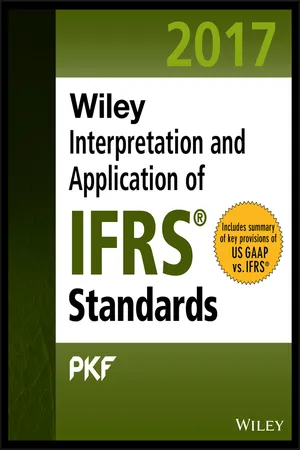
- English
- ePUB (mobile friendly)
- Available on iOS & Android
About this book
The one-stop resource for IFRS interpretation and application, updated for 2017
Wiley IFRS 2017 offers a complete resource for the interpretation and application of the latest International Financial Reporting Standards (IFRS) as outlined by the International Accounting Standards Board (IASB). With up-to-date coverage and a host of practical tools, this book provides invaluable guidance on the expanding framework for unified financial reporting. Organised for easy navigation, each chapter includes general statement information followed by topic-specific discussion to facilitate both quick-reference and in-depth study. The expert team at PKF International provides authoritative insight from a practitioner's perspective: IFRIC interpretations and practical real-world guidance ensure full understanding of the newest standards, and the Disclosure Checklist helps verify compliance.
The IASB's efforts are paying off as more and more countries around the globe either adopt IFRS as their national standards, or adjust local standards in alignment. A working understanding of IFRS application is becoming essential, even as the rules continue to evolve. This book provides full coverage of the latest standards and thorough guidance for implementation.
- Review the latest IFRS rules and standards
- Apply guidelines and best practices appropriately
- Gain expert insight on IFRS interpretation and implementation
- Ensure compliance and verify completeness
Uniform financial reporting reduces the costs of financial statement preparation for multinational companies, and streamlines the assessment of business results. As the standards themselves evolve, so must practitioners' understanding of how to apply them correctly in real-world cases. Wiley IFRS 2017 offers a complete, up-to-date reference to help you apply and comply with the latest international standards.
Frequently asked questions
- Essential is ideal for learners and professionals who enjoy exploring a wide range of subjects. Access the Essential Library with 800,000+ trusted titles and best-sellers across business, personal growth, and the humanities. Includes unlimited reading time and Standard Read Aloud voice.
- Complete: Perfect for advanced learners and researchers needing full, unrestricted access. Unlock 1.4M+ books across hundreds of subjects, including academic and specialized titles. The Complete Plan also includes advanced features like Premium Read Aloud and Research Assistant.
Please note we cannot support devices running on iOS 13 and Android 7 or earlier. Learn more about using the app.
Information
1
Introduction to International Financial Reporting Standards
- Introduction
- Origins and Early History of the IASB
- The Current Structure
- Process of IFRS Standard Setting
- Convergence: The IASB and Financial Reporting in the US
- The IASB and Europe
- Appendix A: Current International Financial Reporting Standards (IAS/IFRS) and Interpretations (SIC/IFRIC)
- Appendix B: Projects Completed Since Previous Issue (July 2015 to June 2016)
- Appendix C: IFRS for SMEs
- Definition of SMEs
- IFRS for SMEs is a Complete, Self-Contained Set of Requirements
- Modifications of Full IFRS Made for IFRS for SMEs
- Disclosure Requirements under IFRS for SMEs
- Maintenance of the IFRS for SMEs
- SME Implementation Group
- Implications of the IFRS for SMEs
- Application of the IFRS for SMEs
Introduction
Origins and Early History of the IASB
Table of contents
- Cover
- Series Page
- Title Page
- Copyright
- About the Authors
- Chapter 1: Introduction to International Financial Reporting Standards
- Chapter 2: Conceptual Framework
- Chapter 3: Presentation of Financial Statements
- Chapter 4: Statement of Financial Position
- Chapter 5: Statements of Profit or Loss and Other Comprehensive Income, and Changes in Equity
- Chapter 6: Statement of Cash Flows
- Chapter 7: Accounting Policies, Changes in Accounting Estimates, and Errors
- Chapter 8: Inventories
- Chapter 9: Property, Plant and Equipment
- Chapter 10: Borrowing Costs
- Chapter 11: Intangible Assets
- Chapter 12: Investment Property
- Chapter 13: Impairment of Assets and Non-Current Assets Held for Sale
- Chapter 14: Consolidations, Joint Arrangements, Associates and Separate Financial Statements
- Chapter 15: Business Combinations
- Chapter 16: Shareholders' Equity
- Chapter 17: Share-Based Payment
- Chapter 18: Current Liabilities, Provisions, Contingencies and Events after the Reporting Period
- Chapter 19: Employee Benefits
- Chapter 20: Revenue Recognition, Including Construction Contracts
- Chapter 21: Government Grants
- Chapter 22: Leases
- Chapter 23: Foreign Currency
- Chapter 24: Financial Instruments
- Chapter 25: Fair Value
- Chapter 26: Income Taxes
- Chapter 27: Earnings Per Share
- Chapter 28: Operating Segments
- Chapter 29: Related-Party Disclosures
- Chapter 30: Accounting and Reporting by Retirement Benefit Plans
- Chapter 31: Agriculture
- Chapter 32: Extractive Industries
- Chapter 33: Accounting for Insurance Contracts
- Chapter 34: Interim Financial Reporting
- Chapter 35: Hyperinflation
- Chapter 36: First-Time Adoption of International Financial Reporting Standards
- Index
- End User License Agreement